 |
| ORCA concept. (Graphic courtesy Canadian American Strategic Review) |
For nearly 50 years, naval personnel were trained on vessels known as YAG's. They provided an invaluable and relatively inexpensive at-sea training for junior naval officers, boatswains, reserve personnel and Sea Cadets. By the year 2000, a total of 1830 personnel had been deployed on the YAGs for a total of 585 days and steamed over 25,000 nautical miles in support of training.These wooden-hulled vessels had become prohibitively expensive to maintain, hence replacement became the only option. The lack of current technology, proper environmental systems, poor habitability and inadequate workspaces did not meet the Navy’s requirements, and reflected poorly on the Canadian Forces.
Replacement of the YAG fleet began in July 2001 when the project was formally identified. Following a thorough analysis of replacement options, it was decided that purchasing a proven commercial design would significantly reduce the risk to the Crown. In October 2001, the project issued a Letter of Interest to industry seeking responses from companies who had a proven capability in the construction of vessels of similar size and complexity within the last ten years. Five companies responded to the Letter of Interest and a request for proposals was subsequently issued in December 2003. The competition closed in April 2004, and the submissions were evaluated against the mandatory requirements.
The new vessels, designated the ORCA class training vessels will provide an excellent means for both the Regular Force and Reserve officers to hone their bridgemanship and navigation skills. It will have significant advanced training capabilities, closely simulating the performance and conditions experienced on the major warships. The vessels will have a twin shaft configuration to provide excellent shiphandling characteristics and be able to conduct transits at much higher speeds. The contract was awarded to Victoria Shipyards and the first vessel, PCT55 , began taking shape.
As sailor's cheered and waved their hats, Orca was officially accepted into the Canadian Navy during a ceremony on Nov. 17, 2006. It was to be the first of eight new Patrol Craft Training (PCT) vessels, Orca features a bridge with navigation electronics updated from the previous Yard Auxiliary General (YAG) 300 series vessels including a global positioning system and improved accommodations. Crew will be housed in double cabins, while cabins of between four and six bunks will house trainees. This vessel reflects the rest of the fleet much more than the YAG's did and is several generations advanced from what the navy had been using for training vessels.
 |
| ORCA concept. (Graphic courtesy Canadian American Strategic Review) |
Neil Bell, who toured an Ocra, observed a few of the advanced features found in these vessels. "The helmsman’s position has a chair and a wheel and throttles rather than the combi-levers of the MCDVs as well as two computer screens that can pull up any of numerous “pages” of information regarding propulsion, electricity, tank capacity, etc. The switchboard automatically adds or takes off line generators according to the electrical load. A screen in the CO's cabin allows him/her to access any information that is presented to the bridge."
Most importantly, the ORCA class will allow the freeing of the HALIFAX frigates and KINGSTON defence vessels from cadet training duties. As a result, there will be less of a backlog created by the wait for one of those larger vessels to be freed up from regular duties for training. Furthermore, not having to employ large vessels like the 240-crew HALIFAX for mere cadet training duties will be highly economical to the military.The ships, built by Victoria Shipyards Vancouver, replace the 50-year-old wooden hulled YAG training vessels. Malcolm Barker, general manager of Victoria Shipyards Limited handed over Orca 55 to Cmdre David Gagliardi, Deputy Commander Canada Command, representing the Chief of Maritime Staff at the ceremony on ''A" Jetty, Esquimalt, BC.
"Today, we usher in a new era in navigation and seamanship training for the Canadian Navy. Designated "Patrol Craft Training", the Orca class ships represent a quantum leap into the future of the Canadian Navy replicating the capabilities found in the Navigation and Bridge Simulator at the Naval Officer Training Centre and on the bridge of the Halifax and Kingston class ships as well as the navy's future ships. Sailors will now train in an environment that emulates the ships they will ultimately serve in," said Cmdre Gagliardi.
After Barker signed over Orca to Cmdre Gagliardi, representatives from the Naval Officer Training Centre (NOTC), the Naval Tender Section and the Royal Canadian Sea Cadets unveiled the kisbee ring at the event. LCdr James Brown, senior chaplain of Canadian Fleet Pacific blessed the ship and then it was time for Orca's future sailors to board and ceremonially man the ship for the first time. Teenage cadets stood next to naval officers on the deck as they waved their hats and shouted, "three cheers for Orca, hip, hip, hooray."
The ORCA class vessels are not in commission with the RCN therefore it would be incorrect to use the prefix "HMCS" in reference to any of the vessels in the ORCA class.
 |
| Orca cutaway. (Graphic courtesy Canadian American Strategic Review) |
The remaining Orca class ships will be delivered in coming months and are named PCT 55 Orca, PCT 56 Raven, PCT 57 Caribou, PCT 58 Renard, PCT 59 Wolf, and PCT 60 Grizzly, plus the two newly added vessels PCT 61 Cougar and PCT 62 Moose. "The names of each of the eight ships remind us of the original sailors on the Pacific coast of North America, the Coast Salish First Nations people," said Cmdre Gagliardi. The names of six of the vessels were names also given to the "armed yachts" the Government acquired in the early years of the Second World War, he added.Orca class is rather broad in the beam due to its training role. Accommodation was a major factor – three crew cabins (for the crew of four) and three large student cabins (for 16 trainees) were required. Duplicate training stations, etc. also imposed additional space and weight requirements. This limits the usefulness of the Orca as a patrol boat.
Although the boats were designed with the Junior Officer Training requirement in mind, they may also provide a secondary inshore patrol capability on the West Coast. All the boats will be based at CFB Esquimalt in British Columbia.
On Thursday November 27, 2008 ship horns blared, a red fireboat spurted fountains of water, and cameras flashed to mark the delivery of Moose, the last of the eight ORCA class training vessels built by Victoria Shipyards. Under bright white tents, 250 shipyard workers were treated to a catered lunch to celebrate their work on the Orca-class vessels. All the vessels were built for $86 million with the last one delivered exactly four years to the day since the contract was signed -- and 14 months early, to boot.
| NAME | RADIO CALL SIGN | LAUNCH DATE | SERVICE DATE |
| Orca (PCT 55) | CGAB | 9 Aug 2006 | 17 Nov 2006 |
| Raven (PCT 56) | CGAM | 10 Jan 2007 | 15 Mar 2007 |
| Caribou (PCT 57) | CGAA | 2 May 2007 | 31 Jul 2007 |
| Renard (PCT 58) | CGAS | 1 Aug 2007 | 13 Sep 2007 |
| Wolf (PCT 59) | CGBP | 22 Oct 2007 | 29 Nov 2007 |
| Grizzly (PCT 60) | CGCA | 14 Feb 2008 | 19 Mar 2008 |
| Cougar (PCT 61) | CGCY | June 2008 | July 2008 |
| Moose (PCT 62) | CGCZ | Oct 2008 | 27 Nov 2008 |
PHOTO MONTAGE
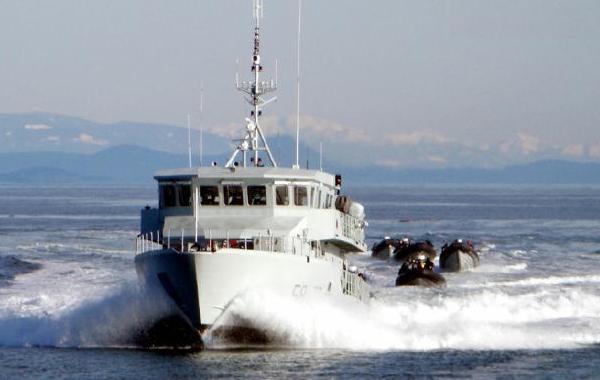 |
| Orca-class training vessel PCT 58 Renard, followed by RCMP rigid hull inflatable boats, conducts maritime boarding exercises near Victoria B.C. in late January 2008. The exercise was part of the RCMP Emergency Response Team’s Maritime Operations course. The navy routinely conducts exercises with other government departments, including the RCMP, to ensure the compatibility of skills and knowledge in the event of local or national emergencies .(RCMP photo in Crowsnest Vol. 2, No. 1 Spring 2008) |
 |
| Orca-class training craft are seen in North Vancouver on July 25, 2008. (Photo by Dave Shirlaw) |
TECHNICAL DATA
Note: There are minor differences in some of these specifications depending upon the source of the data. Orca’s design is restricted by its training role. Other than a higher top speed, the sole concession to patrol duties are a bow gun, namely a 12.7 mm M2 machine gun.
|
|
||
| General Particulars:
Length, overall .......... 33.00 m
|
Speed/Range:
Maximum speed ...... 18 knots
|
Complement:
4 crew
|
| Tank Capacities:
Fuel Oil .............. 25000 litres
|
Certificates:
Classification ........ ABS – High Speed; Naval – Coastal. MARPOL ................ 73/78 Transport Canada ...... Home Trade II Construction Material...Steel
|
Propulsion:
Main Engines .......... 2 x Caterpillar 3516B rated 1864 kW at 1,600
rpm. 69 litres each.
|
| Deck Equipment:
Deck Crane/Davits ..... Allied Systems D2500S Daughter Boat ... 1 x Zodiac SR2 Anchor Windlass ....... Muir VRC 11000 |
Navigation:
Perlorus ....... Anschütz 142-117 [4] Radars/APAR (Two). Raytheon NSC1810 [1] D-GPS (Two) Raytheon MX420/2 Speed Log ... DL850 or SAL-R1 AIS ..........Raytheon RM 80AS [3] Gyrocompass ... Anschütz 110-233 [4,6] Echo Sounder... Raytheon GDS101 |
Communications:
VHF .......... Sailor RT4822 DSC VHF Portable .......... SP3300 VHF DF .... .. Taiyo TD-L1630A [5] MF/HF/SSB .... Sailor HC4500B Fixed Wireless Terminal.... Telular SX3E [2] Multiband Transceiver . Wulfsberg RT-5000 SART .................. Kannad EPIRB ................. S1210 Batteryless Telephone ..... Zenitel Talkback/PA System .... Zenitel
|
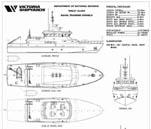 |
ORCA Class profiles. Click to enlarge. (Drawing courtesy Victoria Shipyards, Victoria B.C. Submitted by Jarrod David) |
ORCA INTERIOR SPACES
 |
|
|
 |
|
|
 |
|
|
 |
|
|
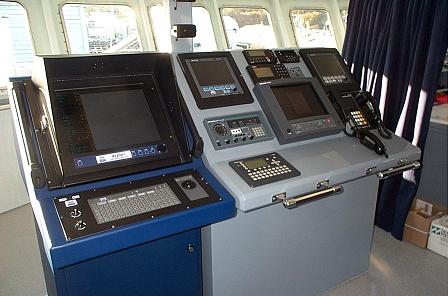 |
|
|
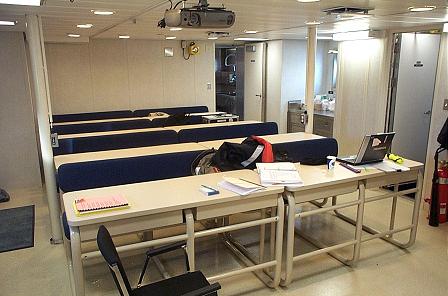 |
|
|
 |
|
|
NAVIGATION AND COMMUNICATIONS EQUIPMENT DETAILS (2006)
RADIO and SOUND EQUIPMENT
Click to enlarge.
 |
VHF Comm - Sailor Model RT4822 DSC. The Sailor RT4822 VHF DSC
simplex/semiduplex VHF radiotelephone with built-in DSC is a part of Sailor's
compact System 4000 GMDSS solution.
Frequency range: 150.8 MHz - 163.6 MHz
|
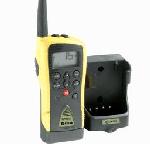 |
VHF Portable Radio - Sailor Model
SP3300. This is a portable GMDSS VHF transceiver.
Normal channels: 54 international channels
|
 |
VHF DF - Taiyo Model TD-L1630A
Triple superheterodyne set with synthesized local oscillator.
|
| MF/HF/SSB - Sailor Model HC4500B. This is a three piece radio.
Pictured (L-R) is the transceiver unit, the control head/handset and the
antenna tuner.
Modes: SSB telephony and Double Sideband AM
|
|
 |
Fixed Wireless Terminal - Telular Model
SX3E.
This terminal provides access for up to five pieces of standard telephone equipment to the cellular telephone network. This can include a voice normal telephone, a FAX machine or a modem equipped computer. (Image courtesy Telular Corp) |
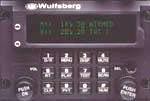 |
Multiband Transceiver - Wulfsberg Model RT-5000. Pictured is
the base-model control head. This radio consists of a transceiver unit
and a control head.
The RT-5000 can take the place of six transceivers since it can cover the bands 30-50, 118-136, 136-174, 220-240, 400-512 and 800 to 960 MHz. In addition, an optional second receiver called a "guard" can be added for monitoring an additional frequency. This receiver can be a single channel crystal-controlled receiver or a synthesized 29.7-960 MHz receiver. Each RT-5000 radio contains a frequency synthesized main receiver/transmitter capable of operating from 29.7 to 960 MHz. With a synthesizer capable of tuning in 1.25 kHz steps, all RT-5000 models can operate on 12.5 kHz and 25 kHz FM channels. Two other IF bandwidths, 35 KHz and 70 KHz, come standard for interfacing with military encryption systems. Power/Modes: 10 watts using FM., 15 watts using AM
|
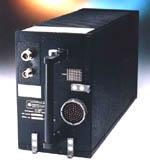 |
Wulfsberg RT-5000 base-model transceiver unit for use with the control head shown above. Dimensions: 4.88 in W x 7.54 in H x 14 in D. (Image courtesy Wulfsberg Electronics) |
 |
SART by Kannad. SART (Search
and
Rescue
Transponder)
is a 9 GHz receiver/transmitter. On receiving a pulse from any standard
9 GHz X-band radar, the SART immediately transmits a signal which clearly
identifies the survival craft on the radar screen. The SART code
displayed on the radar screen is a series of dots extending radially outwards
from the location of the transponder. The series of dots represents a range
of approximately 10 nautical miles. This indication is an internationally
accepted signal for Search And Rescue operations. The device pictured in
the photo is intended for use in a life raft. (Image courtesy Martec)
Bigger image not available |
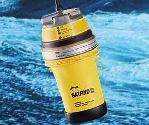 |
EPIRB - Model S1210 . The S1210
is an Emergency Position Indicating Radio Beacon (EPIRB) and is a vital
safety aid for all vessels. Once activated, the SS1210 will send
an encoded distress signal, indicating the location of the emergency and
the EPIRB's unique ID, to the nearest search and rescue center.
The EPIRB's ID number is kept on file by the National Oceanic and Atmospheric Association (NOAA) in the US and the National Search and Rescue Secretariat (NSS) in Canada. When a 1210 is purchased, there is a registration card that must be filled out and sent to NOAA in the US or NSS in Canada. This ID number tells the search and rescue centre who owns the vessel, the size and name of the vessel, the next of kin, the home address and phone number of the EPIRB owner. The device uses a Xenon light strobe for visual identification, a 121.5 MHz (VHF distress) local homing radio signal and a 406.028 MHz satellite transmitter. (Photo courtesy Rapid Response Marine) |
| Batteryless Telephone - Zenitel Model VSP. It is designed as replacement of the traditional sound powered telephone. Cranking the phone charges a capacitor-battery which can provide up to 20 minutes of talk time before the unit needs re-cranking. Optionally, the system can also be operated from a 24 VDC external power source to eliminate cranking. By use of a dynamic microphone and a "receiver-insert" , a sound level four times louder than a traditional Sound Powered Telephone can be achieved. A PDF file explaining the telephone system diagram can be found here. (Images and courtesy Zenitel Group) | |
 |
PA System - Zenitel Model SPA. The system has up to 4 zones, and operates either 230 VAC or 24 VDC. It is tested according to EN 60945 and type approved by RMRS and CCS. System options are: Chime generator, rack expansion, alarm generator modules, monitor modules wtih speaker/volume control and a radio/CD player. (Image courtesy Zenitel Group) |
NAVIGATION EQUIPMENT
Click to enlarge
NOTES:[1] According to Canadian American Strategic Review, "for a training role, the Orcas will be fitted with the Raytheon Pathfinder NCS 18 X-band navigation radar (illustrated) and the MX420 DGPS which makes use of four Canadian Coast Guard DGPS stations on the west coast and a Anschütz Pelorus (dumb) compass". It is believed that the 1810 would be fitted if the Orca is assigned to patrol vessel duties. Can anyone confirm this?
[2] This is listed as a Cellular Telephone on other web sites. It is correctly shown here as a Fixed Wireless Terminal with the correct spelling of the company name.
[3] The Raytheon Model RM80 AS could not be located on the web. Raytheon's current product line (2006) illustrates model RM808AIS so it is believed there may be an error in the equipment manifest. Instead, the Model RM808 is shown.
[4] The company name has been corrected. IT should read as "Anschütz". This is a division of Raytheon.
[5] The full company name is Taiyo Musen but they market their products under the shortened "Taiyo" brand.
[6] No such model as 110-233 could be located on the web. The only Raytheon gyrocompass located was the Standard 22 product, so it is assumed that this is the one being referenced in the equipment manifest.
[7] Nothing was found on the web when searching for "Anschütz Pelorus" or in combination with the indicated model number. Is there any source for an image of the device?
Contributors and Credits:1) Pam Lloyd, Staff Writer, Lookout Newspaper
2) http://en.wikipedia.org/wiki/Orca_class_training_vessel
3) Canadian American Strategic Review http://www.sfu.ca/casr/bg-orca-project.htm
4) Michael Golden <navalofficerca(at)yahoo.ca>
5) Jarrod David <jdavid235(a)ns.sympatico.ca>
6) Orca technical specifications source: www. cadet-World.com (Nov 15/06) Published by LCdr Gerry Pash.
7) George Keats <gkeats(at)mergetel.com>
8) Darren Scannell <hawkone@hawk-graphics.com>
9) Rapid Response Marine http://www.rapidresponsemarine.net/index.asp?PageAction=VIEWPROD&ProdID=40
10) Zora Technologies http://www.zora.ru
11) Wulfsberg Electronics http://www.wulfsberg.com/Flexcomm_Products.htm
12) Martec Group http://en.martec.fr/page/p-176/art_id-753/
13) Taiyomusen http://www.taiyomusen.co.jp/EHome/edf.html#TD-L1630
14) Busse Yachtshop http://www.bordelektrik.de/dae_sailor-sp3300.html
15) Telular Corp https://www.telular.com/v2/html/support/56017302.pdf
16) Raytheon Marine http://www.raytheon-marine.de/highseas/products/commercial/radar/nsc_radar.html
17) MX Marine http://www.mx-marine.com/products/index.html
18) Klein Associates http://www.l-3klein.com/navigation/raytheon_rm808ais/rm808auto_id_sys.html
19) Raytheon Marine http://www.raytheon-marine.de/highseas/products/commercial/navigation/graphic_depth_sounder.html
20 ) Orca Equipment Manifest: http://www.navy.forces.gc.ca/marpac/news/marpac_news_e.asp?section=9&category=38&id=696
21) Raytheon Marine http://www.raytheon-marine.de/highseas/products/commercial/navigation/gyro_compass_std22.html
22) Radio Holland USA http://www.radiohollandusa.com/products/index.htm?&brochures.html
23) Neil S. Bell <rcnr(at)mountaincable.net>
24) http://www.l-3klein.com/navigation/repeater_compass/repeater_compass.html
25) Zenitel Group http://www.zenitel.biz/index.php?option=com_content&task=view&id=294&Itemid=223
25) Jim Brewer <snack.235(at)sympatico.ca>
26) A/SLt Nick Kucher
27) Dave Shirlaw <djshirlaw(at)shaw.ca>
28) Silvester.Lt(N).TD RCIS(Pac) <silvester.td(at)cadets.net>
29) http://en.wikipedia.org/wiki/Orca_class_patrol_vesselBack to Table of Contents
Feb 10/12